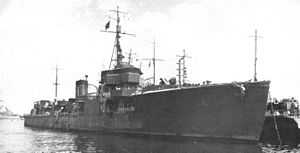Japanese destroyer Sawakaze
 Japanese destroyer Sawakaze in 1945 | |
| Career (Japan) | |
|---|---|
| Name: | Sawakaze |
| Ordered: | 1917 fiscal year |
| Builder: | Mitsubishi-Nagasaki, Japan |
| Laid down: | January 7, 1918 |
| Launched: | January 7, 1919 |
| Commissioned: | March 6, 1920 |
| Struck: | September 15, 1945 |
| Fate: | scuttled as breakwater, 1948 |
| General characteristics | |
| Class and type: | Minekaze-class destroyer |
| Displacement: | 1,345 long tons (1,367 t) normal, 1,650 long tons (1,680 t) full load |
| Length: | 97.5 m (320 ft) pp, 102.6 m (337 ft) overall |
| Beam: | 9 m (30 ft) |
| Draught: | 2.8 m (9.2 ft) |
| Propulsion: | 2-shaft Mitsubishi-Parsons geared turbines, 4 boilers 38,500 ihp (28,700 kW) |
| Speed: | 39 knots (72 km/h) |
| Range: | 3600 nm @ 14 knots (6,700 km at 26 km/h) |
| Complement: | 148 |
| Armament: | 4 × Type 3 120 mm 45 caliber naval gun 6 × 21 in (533 mm) torpedo tubes 2 × 7.7 mm machine guns |
| Service record | |
|---|---|
| Operations: |
Second Sino-Japanese War Pacific War |
Sawakaze (澤風 "Marsh Wind")[1] was a Minekaze-class destroyer, built for the Imperial Japanese Navy immediately following World War I. Advanced for their time, these ships served as first-line destroyers through the 1930s, but were considered obsolescent by the start of the Pacific War.
History
Construction of the large-sized Minekaze-class destroyers was authorized as part of the Imperial Japanese Navy's 8-4 Fleet Program from fiscal 1917-1920, as an accompaniment to the medium-sized Momi class with which they shared many common design characteristics.[2] Equipped with powerful engines, these vessels were capable of high speeds and were intended as escorts for the projected Amagi-class battlecruisers, which were ultimately never built.[3]
Sawakaze, built at the Mitsubishi shipyards at Nagasaki, was the second ship of this class. It was laid down on January 7, 1918, launched on January 7, 1919 and commissioned on March 6, 1920.[4]
On completion, Sawakaze was teamed with sister ships Minekaze, Okikaze, and Yakaze at the Sasebo Naval District to form Destroyer Division 2 under the IJN 2nd Fleet.
From 1930-1932, Destroyer Division 2 was reassigned to the IJN 1st Air Fleet as part of the escort of the aircraft carrier Akagi to assist in search and rescue operations for downed aircraft.
At the time of the First Shanghai incident of 1932, Destroyer Division 2 was engaged in river patrol duties along the Yangzi River in China.
From 1935 to December 1938, Sawakaze was assigned to the Tateyama Naval Air Base as a search and rescue craft, and was scheduled to be retired at the end of 1938; however with the start of the Second Sino-Japanese War, it was kept on active status, and assigned to the Yokosuka Naval District. It remained based at Tateyama until March 1942.
World War II history
At the time of the attack on Pearl Harbor, Sawakaze was still based at Tateyama. It was reassigned to Yokosuka from March 1942 and assigned anti-submarine patrols of the entrance of Tokyo Bay for the duration of the war, making only an occasional convoy escort run along the coast of Japan to Muroran, Hokkaidō or Kobe.[5] From December 1944, it was taken off of active combat status and assigned as a training ship for the Yokosuka Anti-submarine Warfare School. In its February 1945 revamp, Sawakaze gained a Type 22 radar, four Type 96 25 mm AT/AA Gun, a nine-tube 15-cm rocket launcher, and 36 depth charges. All torpedo launchers and the front three main gun mounts were removed.
From May 1945, Sawakaze served as a target vessel for the 1st Tokko Air Corps suicide flights. Sawakaze was at Yokosuka at the time of the surrender of Japan. It was removed from navy list on September 15, 1945, and was subsequently scuttled to become part of the breakwater at the port of Onahama Port, Fukushima prefecture.
References
Books
- Howarth, Stephen (1983). The Fighting Ships of the Rising Sun: The Drama of the Imperial Japanese Navy, 1895-1945. Atheneum. ISBN 0-689-11402-8.
- Jentsura, Hansgeorg (1976). Warships of the Imperial Japanese Navy, 1869-1945. US Naval Institute Press. ISBN 0-87021-893-X.
- Nelson, Andrew N. (1967). Japanese-English Character Dictionary. Tuttle. ISBN 0-8048-0408-7.
- Watts, Anthony J (1967). Japanese Warships of World War II. Doubleday. ASIN B000KEV3J8.
- Whitley, M J (2000). Destroyers of World War Two: An International Encyclopedia. London: Arms and Armour Press. ISBN 1-85409-521-8.
External links
- Nevitt, Allyn D. (1997). "IJN Sawakaze: Tabular Record of Movement". Long Lancers. Combinedfleet.com.
- Nishidah, Hiroshi (2002). "Minekaze class 1st class destroyers". Materials of the Imperial Japanese Navy.
- Jones, Daniel H. (2003). "IJN Minekaze, Kamikaze and Mutsuki class Destroyers". Ship Modeler's Mailing List (SMML).
Notes
- ↑ Nelson. Japanese-English Character Dictionary. pages 537, 960
- ↑ Howarth, The Fighting Ships of the Rising Sun
- ↑ Globalsecurity.org, IJN Minekaze class destroyers
- ↑
- Nishidah, Hiroshi (2002). "Minekaze class 1st class destroyers". Materials of the Imperial Japanese Navy.
- ↑ Nevitt, Allyn D. (1997). "IJN Sawakaze: Tabular Record of Movement". Long Lancers. Combinedfleet.com.
| ||||||||||||||||||||||||||||||||